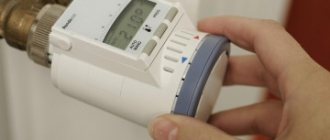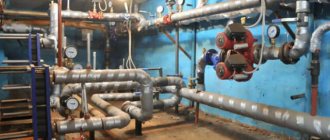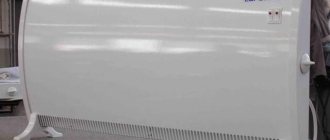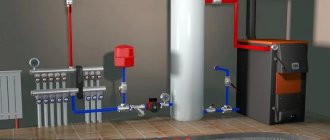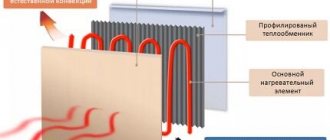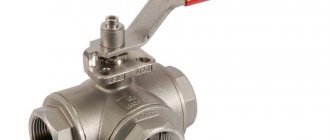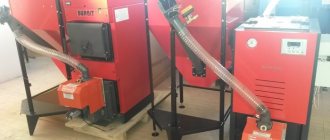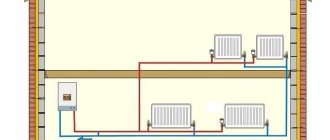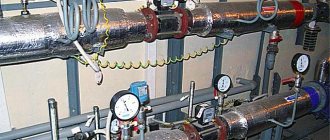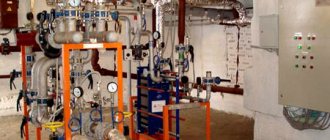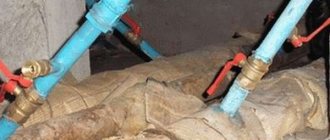Recently, heating meters have been in particular demand, as they can reduce heating bills by almost half. Let's find out what is the reason for the demand and whether heat meters help you save money, what types of devices there are, and on what principle they work. We’ll figure out how to install the devices correctly and whether it’s possible to do it yourself, where to get permission and how to take readings correctly.
Individual counter Source cstor.nn2.ru
Vortex heating device
This meter can be installed on pipes, both horizontal and vertical.
The principle of operation is to measure the speed and number of vortices. That is, this is an obstacle to the flow of water; the water bends around the obstacle and, as a result, vortices are created. It is not sensitive to the manifestation of various blockages, for example, rust, scale, etc. This meter can only give incorrect readings if there is air in the system. Complete set of vortex heating device:
- Counting mechanism;
- Frame;
- Plates;
- Heat fairing;
- Filter.
Rice. 5 Vortex device
The vortex counter is installed horizontally between two pipes.
General and individual meters
The heat meter can be installed on:
- the central collector of a multi-storey building - the heat received by all apartments connected to the riser is taken into account;
- separate pipes - the resource entering a specific apartment is registered.
Ultrasound devices are used individually. Mechanical, electromagnetic and vortex devices can be installed both for the entire house and for a separate apartment.
Read in a separate article: Hot water meters with a temperature sensor and their features.
Common house
The house-wide heat meter is connected to the main riser, which is located in the basement and supplies heat to all apartments. How to calculate heating in an apartment using a meter? Cost accounting is carried out as follows:
- On a certain date of the month, current heat meter readings are taken.
- The difference between them and the previous number of gigacalories is found.
- The resulting number is multiplied by the current tariff assigned by the state.
- The amount is divided between apartments in proportion to their area.
As a result, residents pay for the heat that is supplied to their apartments and also used to heat stairwells, basements, attics, and so on. Community meters are expensive. The price of the device itself can reach 150,000 rubles, in addition, there are costs for its installation and maintenance. All costs are divided equally between the apartments. In many cases, residents are allowed to pay the amount in installments over time.
Household ultrasonic meter
Individual
With all their advantages, communal heating meters have some disadvantages:
- To install the device, the consent of all residents is required, which is sometimes impossible to obtain;
- the device does not take into account the uneven distribution of heat - in insulated apartments that are located in the middle of the house, the temperature will be higher than in corner and “ventilated” ones, but the payment is the same for everyone (taking into account the area);
- Even if there are thermostats on batteries, it makes no sense to screw them on in order to save money, since this does not affect the amount of payment for heating.
Meters for heating batteries in the apartment will help solve these problems. The costs of purchasing, installing and ongoing repairs of the device fall entirely on the shoulders of the home owner, but he gets the opportunity to clearly control the heat received on his own. The device is mounted on an individual riser that supplies coolant to the apartment.
Before making a decision, you should find out whether it is possible to install a heating meter in the apartment? The fact is that in most old houses the wiring from the riser goes vertically, that is, each radiator has its own pipe. It turns out that all of them need to be equipped with devices. But this is very expensive, and in addition, it is almost impossible to reconcile the readings of many meters. The way out of the situation is to install distributors on all radiators. These devices determine the temperature difference on the surface of the battery and in the room.
Radiator distributor
However, not all operating companies accept such readings to account for the heat received and calculate the cost of services. With horizontal wiring of the heating system, you can install any type of meter.
Measurement accuracy
Like any device, a heat meter has a certain error, which consists of the errors of individual elements. In a residential area, the general error is 6-10%, but actual figures may vary.
The error may increase if:
- The difference between the inlet and outlet temperatures is less than 3 degrees.
- Errors were made when installing the meter. It is important to remember that if the installation was carried out by an unlicensed company, the manufacturer will not cover it under warranty.
- There are impurities in the water, including mechanical ones, or it is too hard, the pipes are old and rusty.
- The water flow is weaker than specified in the technical specifications.
Installation of a heat meter Source eno-tek.ru
In the USSR, the amount of heat was calculated in gigacalories (Gcal), in Europe - in gigaJoules (Gj). The international unit of measurement is kWh. When taking data, you can convert data from one measurement system to another by multiplying by a coefficient.
How the battery meter works
Let's take a closer look at how the heating meter works and what factors can affect its functioning.
A heat meter is installed to determine the volume of coolant in the radiator, as well as measure the water temperature level.
If the house has horizontal wiring, the unit is mounted on a horizontal pipe. At the same time, one device per apartment is quite enough. But with vertical piping, you will have to install a separate meter for each battery.
It should be noted that the heating meter in the apartment is quite accurate. But there are a number of factors that can have a strong impact on the device and cause some error. For example:
- The circulation of the coolant is disrupted, low flow is observed.
- There is a thermal difference that is less than +30 degrees.
- The meter was installed incorrectly. For example, temperature sensors are installed incorrectly.
- The quality of the pipeline and water is poor. For example, the water is too hard and has various impurities such as sand and rust.
What types of heating meters are there?
Depending on the installation method, the heating meter can be communal or individual. With the common building option, one metering device is purchased for the entire high-rise building. Despite the fact that the meter is expensive, it will be quite affordable for the owner of each apartment. After all, the total price will be divided among all residents. Despite the availability of a heat metering unit, savings may be low due to the fact that some apartments may be poorly insulated. As a result, everyone will have to overpay.
Therefore, many people prefer to install an individual meter on the heating battery. to pay only for the heat actually received by the apartment. True, such a device is not suitable for every room. For example, installing a meter in an old house with a vertical type of wiring can be quite problematic. After all, the device is installed on a riser. And in such houses there are several of them. Installing a meter on each riser is very expensive. In this case, distributors are used.
Also, all heating meters for an apartment can be classified according to their operating principle into:
- Ultrasonic. They are used most often. They are considered the most accurate, durable and reliable. The error may be caused by particles of debris entering the signal receiver and the formation of air bubbles.
- Mechanical. Suitable for use in conditions of contaminated or salt-saturated circulating fluid.
- Electromagnetic. Fairly accurate. They are distinguished by stable operation.
- Vortex. The principle of operation is that data on the strength of the vortices formed after the passage of the circulating fluid is compared.
Features of installing a heating meter
It should be noted that independent installation of heating meters in the apartment is unacceptable. This may result in refusal of registration, and the personal account will not be re-registered
It is also important to remember that the unit should be checked every four years.
To install the device, you need to perform a number of steps:
- get permission;
- study technical conditions;
- create a project, it must be agreed upon with the heating company;
- install the unit.
How much will it cost to install a heating meter?
For those who want to spend money wisely, a heat meter is the best investment option. Of course, the price of the device is considerable. But if you consider that the purchase pays for itself fairly quickly, the meter is not that expensive. The price for a communal heating meter is more affordable than for a unit installed individually for one apartment.
The cost of devices depends on the type and manufacturer. We must remember that in addition to purchasing the device itself, you will also have to spend money on its installation. After all, installation should only be performed by a professional. It must be said that the price of heating meters includes, in addition to the equipment itself, some components: shut-off valves, control valve, filter. The average cost is from 9,000 rubles. If you add installation costs to this, the amount can rise to 20,000 rubles.
It is very profitable to buy meters in bulk: at the same time, the price for a heating meter will be slightly lower. This is possible, for example, if other residents plan to install this unit at the entrance for their apartments.
Main technical characteristics
Performance characteristics
Heat meters provide measurement, indication and registration of parameters of the coolant and thermal energy along 1...8 pipelines, their average hourly, average daily and total values, as well as operating time and the duration of emergency situations in its operation. Archive depth – 45 days.
Heat meters provide registration of the specified information on an external device (printer, PC, etc.) via the RS232, RS485, Centronics interface.
The computer is powered from a 220 V AC network.
Metrological characteristics
Heat meters, depending on their configuration with sensors, have the technical characteristics indicated in the table:
| Flow sensor type | Nominal diameter, DN, mm | Limits of flow measurement range, m3/h | Max. temperature value, °C | |
| Gname | Gnaib | |||
| VORTEX | ||||
| VRTK-2000(VPR) | 15-350 | 0.016 Gmax | 4-1600 | 150 |
| VEPS | 25-300 | 0.03 Gmax | 10-1600 | 150 |
| VEPS-TI | 20-200 | 0.04 Gmax | 4-630 | 150 |
| DRC-V | 25-100 | 0.04 Gmax | 10-200 | 150 |
| METRAN-Z00PR | 25-200 | 0.04 Gmax | 9-700 | 150 |
| UPS | 20-200 | 0.04 Gmax | 4-630 | 150 |
| DRG-M | 50-150 | 0.025 Gmax | 160-5000 | 200 |
| ELECTROMAGNETIC | ||||
| PREM | 20-150 | 0.005…0.0067 Gmax | 12-630 | 150 |
| IPRE-1(1M) | 32-200 | 0.05 Gmax | 5,6-900 | 150 |
| IPRE-3 | 32-200 | 0.04 Gmax | 22,7-900 | 150 |
| MP400 | 10-150 | 0.04 Gmax | 3,39-763 | 150 |
| IR-45 | 32-200 | 0.04 Gmax | 22,7-900 | 150 |
| "VOZLET ER" ERSV | 10-200 | 0.012 Gmax | 3,39-1357 | 150 |
| TACHOMETRIC | ||||
| PRMT | 32,50,100 | 0.1 Gmax | 1-100 | 150 |
| VST | 15,20 25-250 | 0.04 Gmax 0.05…0.08 Gmax | 3,5 7-1000 | 90 150 |
| VMG | 50-200 | 0.025 Gmax | 60-500 | 150 |
| OSVI | 25-40 | 0.02 Gmax | 7-20 | 90 |
| WPD, M-T150QN | 20-300 | 0.03… 0.09 Gmax | 3-1000 | 150 |
| M-T, WS, WP | 15-200 | 0.02… 0.05 Gmax | 1,5-600 | 120 |
| ET, WP, MT | 15-250 | 0.04…0.05 Gmax | 3-800 | 90; 120; 130; 150 |
| IMW, MT, E-T, WS, WP | 15-200 | 0.03…0.06 Gmax | 3-600 | 90; 120, 130 |
| ETW, MTW | 15-50 | 0.04…0.1 Gmax | 1,5-30 | 90 |
| ULTRASONIC | ||||
| DRC-S | 50-350 | 0.02 Gmax | 145-1000 | 150 |
| DRC-3 | 80-4000 | 0.01…0.015 Gmax | 18…450000 | 150 |
| EEM-Q | 15-50 | 0.04 Gmax | 1,5-15 | 150 |
| SONOFLO | 25-250 | 0.04 Gmax | 6-1000 | 150 |
| ULTRAFLOW II | 15-250 | 0.03 Gmax | 1,5-1000 | 150 |
| UFM001 | 50-1000 | 0.04 Gmax | 85-34000 | 150 |
| UFM003 | 15-40 | 0.02… 0.04 Gmax | 4,5-30 | 150 |
| UFM005 | 15-1600 | 0.04 Gmax | 2-36200 | 150 |
| UFM500 | >50 | 0.028 Gmax | 31,25-100000 | 150 |
| RU2K | 10-1800 | 0.04 Gmax | 2-110000 | 150 |
| SUR-97 | 25-300 | 0.01 Gmax | 20-2500 | 150 |
| URZH2K | 15-1800 | 0.04 Gmax | 0.034DN2 | 150 |
| UZR-V-M "AKUSTRON" | 50-2000 | 0.03 Gmax | 72-113400 | 150 |
| UFC002R | 50-2000 | 0.04 Gmax | 60-100000 | 150 |
| UFC-003R | 20-50 | 0.025 Gmax | 2,5-25 | 150 |
| UZS-1 | 15-2400 | 0.016 Gmax | 6,3-150000 | 150 |
| UPR-1 | 15-2400 | 0.016 Gmax | 6,3-150000 | 150 |
| URSV-010 | 50-1600 | 0.284DN | 0.028DN2 | 150 |
| URSV-010M “TAKE OFF PC” | 50-4200 | 0.0З Gnaib | 0.03 DN2 | 150 |
| URSV "VZLET MR" | 10-5000 | 0.2Du/r | 0.03 DN2 | 150 |
The calibration interval of the heat meter is 4 years.
Ultrasonic heating heat meter
This type of meters is most often installed as a common device for apartment buildings. The principle of its operation is an ultrasonic signal, thanks to which the device actually takes measurements (using a sensor). This signal is passed through the water. The configuration of this device consists of an emitter and a device that emits a signal. These components are installed one opposite the other.
Rice. 3 Ultrasonic device
It is better to install an ultrasonic device in houses with new pipelines, as they are very sensitive to contamination.
There are the following types of ultrasonic heat meters:
Each of these types gives accurate readings only if the water is clean and free of impurities. Any dirt or even air bubbles will affect the readings.
The advantages of this meter include the information content, which is achieved thanks to the liquid crystal display, and the fact that when installing this model, the hydraulic pressure does not increase.
But there is also one disadvantage in the operation of the ultrasonic device: if the power supply is unstable, then it is connected via UPS.
Transfer of readings
An individual heat meter only records the amount spent. After its installation, the owner will have to record and send data on energy consumed every month. To do this, you will need to record the readings for the current month, then subtract the data from the previous month from them.
To figure out how to take readings from a specific device, you need to study its technical data sheet. There are several ways to do this:
- Devices with a liquid crystal display display readings on the screen, from where they need to be written off.
- Many European models have an ORTO transmitter, which transfers all information to the computer.
- Meters with an M-Bus model are included in the central data collection network. Several devices are connected to each other with a low-current cable and then connected to a hub. The latter regularly sends requests to all heat meters and receives data from them, which is transmitted to the heat supply organization or to a computer.
Meter with display Source deacademic.com
- Some heat metering devices are equipped with a radio module. This allows data to be transmitted wirelessly over distances of several hundred meters. As soon as the receiver is in range, the radio module records the data and transmits it to the heat supply company. Some companies attach a receiver to the garbage truck so that it can regularly collect information along the route.
All data on consumption, downtime, temperatures and errors is stored in the archives of the devices (for some, directly on computers). During installation, you can configure a convenient archiving option - every hour, day, month or year.
If consumption information is not automatically recorded by the heat supply company, it must be sent independently. To do this, you need to create a personal account on the company’s website and regularly enter data.
Types of heat meters
Types of heat meters
Before installing a heating meter in an apartment, you need to choose the right model. Currently, manufacturers offer several options for these thermal energy metering devices. They differ in the principle of taking readings, accuracy and cost.
Considering the general operating principle of a heating meter, they all consist of three separate elements:
- Warm water flow metering unit;
- Two temperature sensors;
- Electronic unit for processing received information from the first two devices.
The difference between the models of heating meters for the battery lies in the principle of taking readings from the coolant volume meter. The remaining components have minor discrepancies between the actual and calculated data on the temperature of hot and cooled water.
The choice of a heat meter for heat supply in an apartment is not affected by the size of the electronic unit. It can be located at a distance from the installation site of the water flow meter.
Mechanical heat meters
These are the simplest and most affordable devices for completing central heating meters. They work on the principle of converting the translational movement of the coolant into the rotational movement of the flow metering unit.
Depending on the operating principle, mechanical heating meters are divided into several types:
The main disadvantage of these devices is the high error with sudden changes in the speed of water movement. You also need to take into account that the rotational element creates a path and small hydraulic resistance. The composition of the coolant has a great influence on the quality of operation of an individual heat supply meter. Mechanical models are not suitable for hard water. In this case, they must be replaced with contactless analogues.
The average cost of mechanical (tachometer) models ranges from 4 to 9.5 thousand rubles.
The easiest way to fool a mechanical heating meter. To do this, it is enough to install powerful neodymium magnets on it. But in addition to a possible fine, such a “modernization” can lead to rapid failure of the device.
Vortex heat meters
The best option for operating a heating meter is to take current readings without directly affecting the coolant flow. Vortex models can be classified as such devices.
Its operating principle is based on the analysis of vortex anomalies that arise due to an artificial obstacle. This design allows you to accurately obtain readings of the volume of water passing through the device. It is also necessary to note the following positive qualities of a vortex heat meter for heating radiators:
- Optional presence of straight sections. This condition must be met only for mechanical models of metering devices;
- The composition of the water will not affect the error, nor will it affect the condition of the meter;
- The presence of metal impurities will not affect the accuracy.
However, the disadvantages of this metering device must also be taken into account. These include the effect of air pockets on the error. Also, the high cost of vortex metering devices makes them unpopular for installation in a heating metering system in private houses and apartments. They are most often used in industrial and commercial areas. Unlike mechanical models, the position of the vortex counter does not affect its operation.
Ultrasonic heat meters
The most unpopular type of heat meters. They work on the principle of changing the time it takes for a sound signal to travel through a liquid. This in turn depends on its speed.
The accuracy of readings is affected by the design of the central unit. It can be of the following types:
An important nuance is the purity of the coolant. It should be free of foreign impurities in the form of scale, rust or high metal content. Otherwise, the accuracy of the instrument readings will significantly deteriorate. Therefore, ultrasonic models are used to a greater extent in closed systems, where accounting for water flow is necessary for organizing the production process.
Even installing a good filtration system will not completely guarantee the absence of third-party impurities in the coolant. Therefore, it is best to refrain from installing ultrasonic meters for your home or apartment.
Length of the straight section of the pipeline.
Many types of flow transducers require long straight runs upstream and downstream of their installation location for correct measurements. This is relevant for ultrasonic and variable pressure flow meters. But in practice, in the absence of suitable premises, it is not always possible to satisfy this requirement.
Measurement channels.
Modern heat meters are complex measuring systems that can simultaneously account for two or more heat inputs and a hot water supply line. In this case, the heat meter becomes universal and can satisfy the requirements of a wide variety of heat consumers.
Availability of a diagnostic system.
Most heat meters are equipped with a self-diagnosis system, which provides periodic automatic checks of the device’s status and provides information about the nature of the failures that have occurred, the time the failures began and their duration. At the same time, the devices can record emergency situations that arise in the heat supply system, such as the current flow rate going beyond the range set for the device or beyond the settings entered into the device memory, power failure, mass imbalance in pipelines, etc.
Energy independence.
Energy independence must be considered from two perspectives: interruptions of the network (220 V) power supply and operational safety. Power interruptions can be dealt with using uninterruptible power supplies, and safety is important when operating heat meters installed in damp and damp rooms (basements), as well as in social facilities: kindergartens, schools, etc.
Terms of Use.
When choosing heat meters, it is necessary to take into account the quality of the coolant. If there is a possibility of mechanical and gas impurities in the water, then it is not recommended to use ultrasonic and tachometer heat meters
In this case, electromagnetic and vortex heat meters are preferable. If there are ferromagnetic impurities in the water, it is not recommended to use tachometer heat meters and vortex meters with electromagnetic signal acquisition. If there are impurities in the network water that form films or deposits on the inner surface of pipelines, it is not recommended to use electromagnetic heat meters, etc.
Completeness of delivery.
When using single heat meters or composite heat meters obtained from one supplier, the compatibility of its blocks and elements and their performance as a whole are guaranteed. Otherwise, there may be problems associated with adapting the heat meter to specific application conditions and not appearing at the commissioning stage.
Intervalidation interval.
Since the verification interval is an economic category (the cost of periodic verification is up to 10% of the cost of the heat meter), heat meters with the largest verification interval should be selected. Currently it ranges from 2 to 5 years for different heat meters.
Availability and depth of the archive.
Almost all modern heat meters archive information with the ability to subsequently retrieve archived data directly from the device or using additional terminals
In this case, the ability to display archived data on the device display is important.
Cost and reliability.
The cost of a set of various heat meters varies over a wide range and depends on the thermal load of the building, the number of heat measurement channels, the need to measure pressure in the pipeline, the presence of additional external equipment (printer, modem), supplier (domestic, foreign) and other factors. The cost of a heat meter directly correlates with reliability.
Installation of equipment
A home owner who has decided to control the consumption and quality of heat should seek advice from specialists. They will tell you how to install a heat meter in an apartment with central heating and help you choose the optimal model.
It should be remembered that even if you have some experience in construction, you cannot do the installation yourself. Manual installation may be the reason for refusal to register the device and re-register a personal account.
Who has the right to install heat meters?
Work on installing heat metering devices can only be carried out by specialists. The performer must:
- have permits (permit, certificate) issued by government agencies;
- be a member of the SRO.
Installing a heat meter in an apartment of an apartment building separately from other residents requires prior contact with a company that has permission to carry out installation.
Its staff will inspect the site to determine the feasibility of installation. Based on the results of the examination, the specialist will draw up an appropriate report.
Installation design and its approval
If installation is possible, you should contact the Housing Office (Management Company) to obtain an opinion on the technical conditions of the installation. To do this, you need to write an application and attach to it:
- a copy of the document confirming the ownership of the living space;
- registration certificate of the apartment.
After this, the contractor will prepare a project and coordinate it with the heat supply company.
Only after receiving the appropriate permission can you buy the device. Make sure the seller has provided the necessary documentation:
- passport,
- quality certificate,
- warranty card,
- cash and sales receipts.
Check for the presence of a stamp and a special sticker. They are confirmation that the equipment has passed initial testing at the manufacturer.
Installation and registration of a heat meter
Specialists from companies that install heat devices know well how to install heat meters on radiators in an apartment, and have the necessary equipment for this. The work is carried out in compliance with existing rules:
- heat meters are installed in accordance with the project;
- no changes are made to the approved project. Any modifications lead to its re-approval;
- installation is agreed upon individually. Standard diagrams for installing devices inside an apartment are not used;
- the specifics of the installation require the presence of straight sections of pipe on both sides of the device;
- installation is carried out so that the equipment can be easily removed for verification or repair without draining water from the system.
After completion of installation work, the device is sealed in the presence of:
- the specialist who performed the installation;
- representative of the Housing Office or Management Company;
- home owner.
The device is then registered with the company that controls the heating of the house.
Popular models
Installing a heat meter in an apartment promises certain benefits - if you have a heat meter, you will have to pay less for heating. True, you will have to spend money on installation work. We recommend the following models as apartment appliances:
Avectra TSU-15/3 is a fairly common metering device for spacious apartments.
- Valtec VHM-T-15/0.6/O/ - can work in hot water supply systems, is equipped with non-volatile memory;
- Avectra TSU-15/3 is a simple and accurate heat meter that can operate in rooms with a total area of up to 300 square meters. m;
- Sayany KST-22 Kombik-M Du-15 KT is one of the simplest and cheapest devices.
Heating meter for apartment
The current tariff schedule for heating payments obliges residents to pay not for the kilowatts spent, but for the heated meters. It does not take into account whether there is heat in the room or not. This situation does not suit an increasing number of people.
There is still debate about how economically beneficial a heating meter is for an apartment, the legality of this procedure and its feasibility.
How to install a heating meter in an apartment?
As many years of practice have shown in installing heating meters in apartments, several nuances need to be taken into account:
- First of all, the heating circuit diagram is important. Thus, in houses that are more than 20 years old, vertical distribution of heating pipes is mainly found, which means that there are several risers in all rooms at once. As a rule, installing heat meters for heating in an apartment building with such a circuit is either impossible or incredibly expensive, since measuring equipment will have to be installed on each riser. In new generation apartment buildings, horizontal wiring is used, in which one riser runs to each apartment. With such a system, there are no legal prohibitions on installing the meter.
- To install a meter, you will need appropriate permission from the organization supplying heat to the house. It must indicate all the technical parameters of the heating system of an apartment building, according to which the measuring device will be selected.
- The purchased meter must be presented for evaluation by the controlling authority, which will register it.
- Representatives of organizations that have the appropriate permission to do so are required to install heat meters for heating in apartments.
Many consumers wonder how profitable all this effort and financial investment is, and how quickly the costs will pay off. There is no definite answer, since even if the heat in the apartment is regulated and it is saved significantly, its residents will be required to pay for heating the common area - the entrance, the basement, if there is one, the staircase.
The only thing that benefits the heat consumer when the meter is running is the ability to turn off heating in rooms where it is not needed. In this case, costs are significantly reduced, which will immediately be reflected in the payment document.
There is no need to install individual heating meters in an apartment if it has not had additional thermal insulation, for example, on the floor or walls, especially if they are external.
When is installation impossible or unprofitable?
The installation of an individual heat meter will be refused by the management company if the multi-storey building does not have a common building heat meter. To calculate the ODN coefficient, you need to know the heat consumption of the entire house.
Payments for a heat meter in the following situations will be higher than without it:
- the entry of the heating main into a multi-storey building was carried out according to an outdated scheme - through an elevator;
- the apartment is located at the end of the house, on the top or first floor;
- there are gaps in the window frames and in the front door frame;
- the loggia (balcony) is not glazed - insulating the balcony can help in such a situation;
- drafty entrance area (broken windows, ajar entrance door), etc.
Note that to minimize heat energy costs, it is not enough to install a common house and apartment meter. It is necessary to modernize the heating system of the building - replacing the elevator unit with AITP or AUU.
The ITP complex allows you to finely regulate the heating of the entire high-rise building. This means heating payments will decrease.
Only in such a high-rise building energy system will it be possible to achieve comfort in apartments with minimal heating payments.
Types of heat meters and their operating principles
Instruments for measuring water and gas consumption have long been familiar to Russians. But many people do not understand how a heat energy meter for an apartment works.
The number of heat meters installed in a room depends on the type of wiring. If it is horizontal, it is enough to install one device. Residents of houses with vertical pipes will face more serious expenses. They will have to install the device separately on each battery.
Each device consists of:
- 2 temperature sensors;
- coolant meter;
- calculator.
The operating principle of the heat meter is simple. Sensors determine the temperature of the medium at the entrance to the system and at the exit from it. The meter records the amount of water passing through the pipes and radiators of the apartment.
The computer analyzes the data received from the listed devices and determines the amount of heat used. This element runs on electricity. No mains connection is required, as its operation is powered by lithium batteries.
It is impossible to unequivocally answer the question of how much a heat meter costs. The cost depends on the manufacturer and type of device. Below we will consider in detail the types of equipment and their features.
Mechanical heat meters
The simplest and most accessible metering device is mechanical. It can be screw, turbine or vane. The equipment can be used even if the coolant is heavily polluted or saturated with salts.
Such a heat meter has its pros and cons. The main advantages are:
- simplicity and reliability of design;
- independence from electricity;
- ease of installation and maintenance;
- Possibility of installation in any position;
- stability of indicators.
Experts recommend installing a deep cleaning filter in front of the device. This will allow you to obtain accurate indicators over a long period.
Among the disadvantages of the device, it is noted that it has a short service life compared to other types.
Ultrasonic heat meters
The legislation of the Russian Federation allows for residential heat metering using various types of equipment. Ultrasonic models are considered the most reliable and durable.
During operation, they record the time of passage of ultrasound along the coolant flow from the source to the receiver. This period depends on the speed of the water: the higher it is, the longer the ultrasound travels.
The device records the signal delay and determines the volume of coolant used. Accurate measurements can be obtained in the absence of impurities and scale.
The consumer can choose between time, Doppler, frequency or correlation ultrasound counters.
Electromagnetic devices
Electromagnetic heating meters for apartment radiators determine the volume of coolant by creating an electromagnetic field. An electric current appears in the water passing through it. The unit detects the current voltage, which increases as the coolant flow accelerates. By assessing these indicators, the device determines the volume of liquid.
If the installation of such a heat meter was carried out by a qualified specialist, and the coolant passing through the device is cleared of impurities, you can guarantee that the device will give the most accurate readings.
